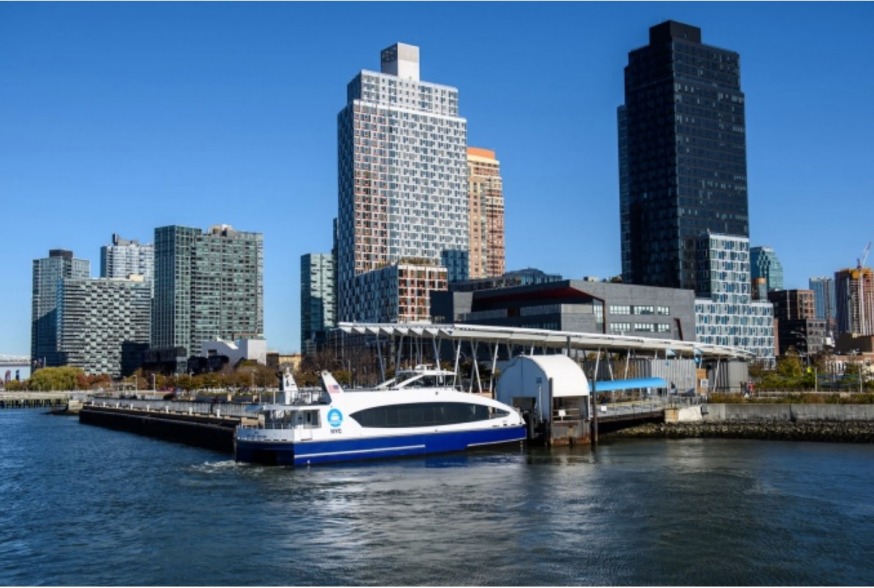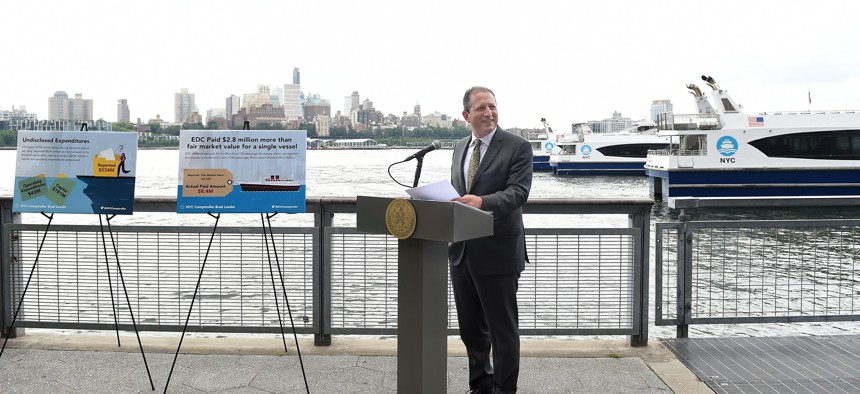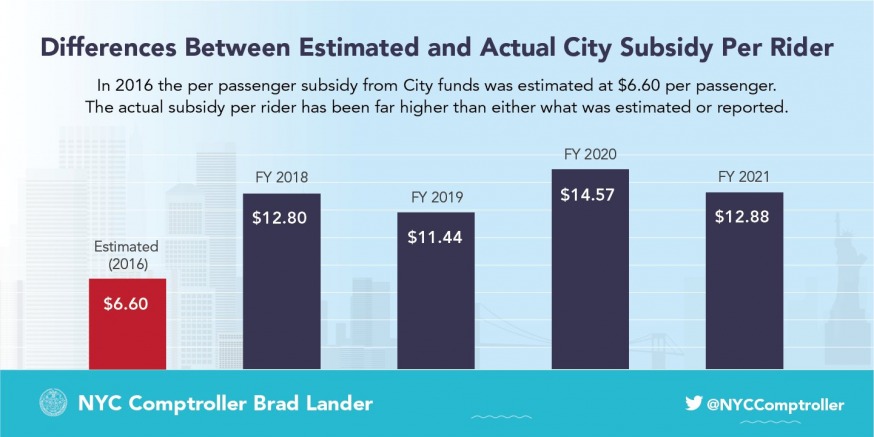
The NYCEDC underreported $224.5 million in NYC Ferry expenditures from July 1, 2015 through Dec. 31, 2021, according to a report released by the NYC Comptroller’s office. The true cost means that taxpayers were subsiding each ferry ride to the tune of $12.88. Photo: NYC Ferry at Hunters Point South Landing (via NYC Ferry)
July 7, 2022 By Christian Murray
The NYC Ferry may only cost passengers $2.75 per ride—but in fiscal year 2021 each ride cost taxpayers nearly $13, according to an audit released by the New York City Comptroller’s office Wednesday.
The findings in the 50-page audit revealed that the NYC Ferry system is much more expensive than what’s been reported, and the system is in need of a management overhaul.
The audit revealed that the NYC Economic Development Corp., which oversees NYC Ferry, had not provided a full account of all the expenses pertaining to the system and that taxpayer subsidies were significantly higher than the public was led to believe.

NYC Comptroller Brad Lander held a press conference Wednesday where he released a report showing that NYC EDC underreported $224.5 million in NYC Ferry expenditures (Photo courtesy of Office of NYC Comptroller)Comptroller Brad Lander, who held a press conference Wednesday at the NYC Ferry terminal in Manhattan’s Financial District, said that between July 1, 2015 through Dec. 31, 2021 only $534 million of the $758.5 million in expenditures were reported—a difference of $224.5 million. The inaccuracy, he noted, has made it difficult to gauge the success—or make changes —to the service.
“This is a very substantial underreporting and mismanagement,” Lander said. “It’s essential that the policy conversation be based on accurate reporting and EDC’s quarter-billion dollar underreporting rendered that impossible.”
The subsidy per ferry ride is nearly double the original estimate of $6.60 when former mayor Bill de Blasio announced a major expansion of the ferry system in 2016, which included adding several new routes.
De Blasio set the price per ride at $2.75 when he expanded the system, lowering it from $4. The system today has six routes with 38 ferries and 25 ferry landing stops.
LIVE: Audit finds EDC underreported the costs of NYC ferry system by $224 million between 2015-2021 https://t.co/EUquxD5sa0
— Comptroller Brad Lander (@NYCComptroller) July 6, 2022
The report was highly critical of the EDC and cited $66 million in unnecessary expenses that contributed to the massive $534 million tab.
These included the early termination of the previous East River operator—Billybey Ferry Company—which managed the East River Ferry line, a loop between East 34th Street and Hunters Point, until de Blasio expanded the system and appointed Hornblower to manage it. Five additional routes were added in 2017 and 2018—including the Astoria route–and the system was branded NYC Ferry.
The EDC incurred costs of $21 million for the early termination of the Billybey contract, which also led to a $3 million transition cost to Hornblower.
Lander’s report also criticized the EDC for failing to hold Hornblower accountable for inflated boat purchases. His office said that the EDC paid $34 million in questionable vessel expenses to Hornblower, which oversaw the acquisition and construction of vessels to launch and expand the system. He said that Hornblower paid $3 million too much for one ferry and the EDC didn’t insist on a refund.
The EDC did acknowledge that the subsidies per ride had increased from the $6.60 initial estimate, stating that the subsidy was $8.59 in FY 2021 and $10.59 in FY 2020. However, the audit, which found $224.5 million in unreported costs, said the true cost of the subsidies were $12.88 in FY 2021 and FY $14.57 in 2020.

The largest element of this understatement of costs stems from the EDC’s decision in 2018 to stop including depreciation, a practice the city had adopted from 2002 until 2017, according to Lander. The city also removed capital expenses from its calculation in 2018, shortly after de Blasio announced a $300 million capital investment in the system.
The ferry system has come under criticism given the level of subsidies, with some noting the subsidies benefit affluent people who live in waterfront communities the most who can afford higher fares.
Lander said that the subsidies would be better geared toward daily commuters—with a different pricing structure for tourists.
He also said that the EDC needs to be a better financial steward.
“For a successful 21st century ferry system, we need more transparent reporting, better cost controls, and a new RFP to operate the system.”
The EDC’s operating agreement with Hornblower is set to expire towards the end of 2023.
The audit made a series of recommendations that the EDC agreed to adopt. These included providing enhanced financial reporting on its website, adding non-operator costs in the subsidy per-ride calculation (such as the cost of maintaining the ferry landings), and issuing a new RFP to determine the operator after 2023.
The EDC, however, did not agree with Lander’s recommendation to claw back overpayments made to Hornblower and did not commit to disclose all ferry-related expenditures in its audited financial statements.
The mayor’s office continues to back the ferry service as a needed mode of transportation and said that it was aware of its financial issues.
”Concerns around the system’s finances are well known – the prior administration rushed NYCEDC to establish a large and complex ferry system, and we are keenly aware there is room for improvement,” a mayoral spokesperson said. “We are working actively on an innovative plan to write a new chapter for the ferry system centered on true financial sustainability and access for communities that need it.”
7 Comments

All public transportation is subsidized by taxpayers. While this mess definitely needs to be sorted out, it would also be helpful to know how much the taxpayer subsidizes each ride on an MTA bus or a ride on the subway. I think we should continue subsidizing public transportation by tolls, like the long-overdue toll on the 59th Street bridge. The fact that’s it free is the main cause of the horrible traffic in that residential neighborhood every morning. Suburban commuters get off the LIE and drive through our neighborhood in order to avoid the toll on the Midtown Tunnel. They cause noise and air pollution and occasionally run over & kill someone who is walking or riding their bike.,
Yet we keep electing the same bad people. Ask yourself next time you vote. How much is the net worth of your candidate. They don’t represent you, they represent interest groups
this service was just made for rich people living on the water in new high rise condos in areas without train service because the river used to be gross and they only built public housing on the East river. how about we just make our existing trains better and make more routes for actual working people who need to use the train
Former Mayor Bill de Blasio assigned the wrong agency to develop his private operator ferry program. NYC EDC had no experience in design and engineering for ferry boats and docks. They also had zero knowledge of ferry operations and management of ferry operator contracts. Contrast that with NYC DOT’s Staten Island Ferry. It manages the nation’s largest municipal ferry system moving 66,000 pre COVID-19 daily riders. The NYCDOT capital ferry program has benefited by over $1 billion in grants from the FTA (previously known as the Urban Mass Transportation Administration), going back to the 1970’s. NYCEDC has no experience in applying for and managing FTA grants. A majority of the Staten Island Ferry system capital program, including the purchase of ferries, Staten Island Pier 7 ferry maintenance facility, both renovated St. George, Staten Island and Whitehall Street, Manhattan ferry terminals, midtown Pier 79 West 39th Street ferry terminal, St. George, Staten Island ferry terminal replacement bus ramps and other support equipment necessary to run the system were all paid for primarily with federal funding. NYCDOT unlike NYCEDC is also experienced in applying for and administering both capital and operating grants from the New York State Department of Transportation. It is time for Mayor Adams to rectify this mistake and transfer management of the NYCEDC Private Ferry Operators program to NYCDOT.
(Larry Penner — transportation advocate, historian and writer who previously worked for the Federal Transit Administration Region 2 NY Office. This included the development, review, approval and oversight between 1984 – 2014 for over $1 billion in grants to NYC DOT. Most of these funds paid for capital and operating assistance to the Staten Island Ferry.).
The EDC needs to be abolished. Why does this organization exist. It is run by the greediest people in the country.
I like landers idea of charging tourist more than local nyc residents. Everytime I ride the ferry ( which is probably 10 times a year) about 2/3rds of the people are tourist taking pictures of everything. Why should we as tax payers fund their vacation ferry ride, so they can post their little social media picture. Good luck!
It should be like the Met if your a nyc resident you pay what you wish for non residents $20 YOU PAY NOW!
Why do the Elite Tower People in Hunters Point/Court Square get to ride the ferry for $2.75? They could easily afford the $6/$7 before it was subsidized. Stop using public tax dollars to support the elite.